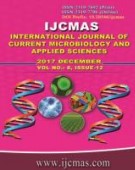


 National Academy of Agricultural Sciences (NAAS)
National Academy of Agricultural Sciences (NAAS)

|
PRINT ISSN : 2319-7692
Online ISSN : 2319-7706 Issues : 12 per year Publisher : Excellent Publishers Email : editorijcmas@gmail.com / submit@ijcmas.com Editor-in-chief: Dr.M.Prakash Index Copernicus ICV 2018: 95.39 NAAS RATING 2020: 5.38 |
An experiment was conducted to study the mean performance and magnitude of heterosis of grain yield per plant and its thirteen yield attributing components in bajara. Experimental material consisting of 60 entries comprised of five male sterile lines and nine lines as well as their 45 hybrids developed through line x tester mating design along with standard check hybrid (GHB 732) were evaluated in a randomized block design with three replications. Perusal of mean data revealed that among females, JMSA 20102 and ICMA 04999 as well as among males, J-2508, J-2503 and J-2433 exhibited higher per se performance for grain yield per plant and its contributing traits. Considering per se performance of hybrids, the superior cross combinations for grain yield per plant were JMSA 20102 x J-2496 (19.56 g), JMSA 20102 x J-2479 (18.13 g) and JMSA 20102 x J-2500 (15.53 g).These cross combinations also had high per se performance for one or more yield contributing traits. Out of twenty eight significant heterotic cross combinations over better parents, nineteen showed positive and significant standard heterosis for grain yield per plant. Thus, the magnitude of heterosis toward the positive direction.The observed range of variation for grain yield per plant in hybrids was varied from 6.63g (ICMA 04999 x J-2510) to 19.56g (JMSA 20102 x J-2496). The general mean of hybrids (10.24 g) and parents (8.27 g) indicated that the hybrids gave higher grain yield as compared to the parents.
 |
 |
 |
 |
 |